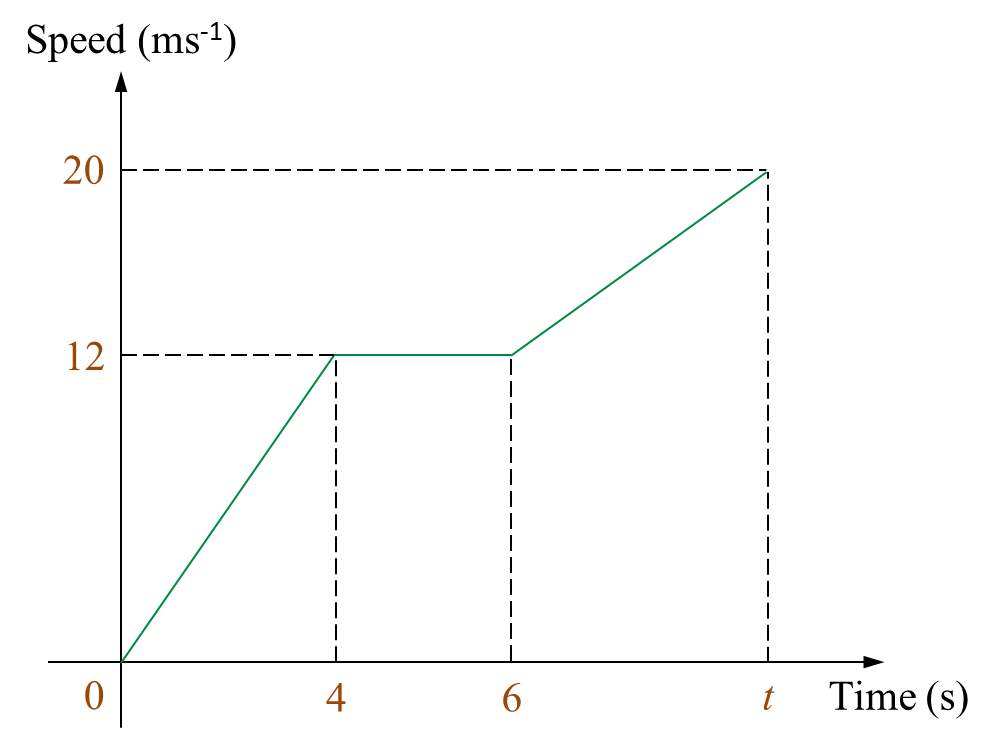Question 11 (6 marks):
Diagram 11 shows the speed-time graph for the movement of a particle for a period of t seconds.
 Diagram 11
Diagram 11
(a) State the uniform speed, in ms-1, of the particle.
(b) Calculate the rate of change of speed, in ms-2, of the particle in the first 4 seconds.
(c) Calculate the value of t, if the distance travelled in the first 4 seconds is half of the distance travelled from the 6th second to the tth second.
Solution:
(a)
Uniform speed of the particle = 12 ms-1
(b)
(c)
Diagram 11 shows the speed-time graph for the movement of a particle for a period of t seconds.
 Diagram 11
Diagram 11(a) State the uniform speed, in ms-1, of the particle.
(b) Calculate the rate of change of speed, in ms-2, of the particle in the first 4 seconds.
(c) Calculate the value of t, if the distance travelled in the first 4 seconds is half of the distance travelled from the 6th second to the tth second.
Solution:
(a)
Uniform speed of the particle = 12 ms-1
(b)
(c)
Question 12 (12 marks):
(a) Complete Table 12 in the answer space, for the equation y = –x2 + 2x + 10 by writing down the values of y when x = –1 and x = 2.
(b) For this part of the question, use the graph paper. You may use a flexible curve ruler.
Using a scale of 2 cm to 1 unit on the x-axis and 2 cm to 2 units on the y-axis, draw the graph of y = –x2 + 2x + 10 for –3.5 ≤ x ≤ 4.
(c) From the graph in 12(b), find
(i) the value of y when x = –1.5,
(ii) the positive value of x when y = 8.2.
(d) Draw a suitable straight line on the graph in 12(b) to find the values of x which satisfy the equation 7 – x = x2 for –3.5 ≤ x ≤ 4.
State the values of x.
Answer:

Solution:
(a)
y = –x2 + 2x + 10
When x = –1
y = –(–1)2 + 2(–1) + 10
y = –1 – 2 + 10
y = 7
when x = 2
y = –(2)2 + 2(2) + 10
y = –4 + 4 + 10
y = 10
(b)

(c) From graph
(i) When x = –1.5; y = 4.6
(ii) When y = 8.2; x = 2.7
(d)
y = –x2 + 2x + 10 ……. (1)
0 = –x2 – x + 7 ………. (2)
(1) – (2): y = 3x + 3

From graph, the values of x are –3.2 and 2.2.
(a) Complete Table 12 in the answer space, for the equation y = –x2 + 2x + 10 by writing down the values of y when x = –1 and x = 2.
(b) For this part of the question, use the graph paper. You may use a flexible curve ruler.
Using a scale of 2 cm to 1 unit on the x-axis and 2 cm to 2 units on the y-axis, draw the graph of y = –x2 + 2x + 10 for –3.5 ≤ x ≤ 4.
(c) From the graph in 12(b), find
(i) the value of y when x = –1.5,
(ii) the positive value of x when y = 8.2.
(d) Draw a suitable straight line on the graph in 12(b) to find the values of x which satisfy the equation 7 – x = x2 for –3.5 ≤ x ≤ 4.
State the values of x.
Answer:

Solution:
(a)
y = –x2 + 2x + 10
When x = –1
y = –(–1)2 + 2(–1) + 10
y = –1 – 2 + 10
y = 7
when x = 2
y = –(2)2 + 2(2) + 10
y = –4 + 4 + 10
y = 10
(b)

(c) From graph
(i) When x = –1.5; y = 4.6
(ii) When y = 8.2; x = 2.7
(d)
y = –x2 + 2x + 10 ……. (1)
0 = –x2 – x + 7 ………. (2)
(1) – (2): y = 3x + 3

From graph, the values of x are –3.2 and 2.2.